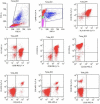Aggressive Natural Killer Cell Leukemia in an Adolescent Patient: A Case Report and Literature Review
- PMID: 35676895
- PMCID: PMC9168658
- DOI: 10.3389/fped.2022.829927
Aggressive Natural Killer Cell Leukemia in an Adolescent Patient: A Case Report and Literature Review
Abstract
Aggressive natural killer cell leukemia (ANKL) is a rare malignant tumor, especially uncommon in children. ANKL has very aggressive clinical course and bad prognosis and is usually caused by Epstein-Barr virus infection. ANKL often has clinical manifestations of hemophagocytic lymphohistiocytosis (HLH) and can be easily treated as HLH, which might complicate this aggressive disease. Here we report an ANKL in adolescent whose clinical presentation was highly aggressive and response to L-asparaginase containing chemotherapy was very bad. Early-onset Flow cytometry of peripheral blood and bone marrow help make the diagnosis.
Keywords: Epstein-Barr virus; aggressive natural killer cell leukemia; case report; children; hemophagocytic lymphohistiocytosis.
Copyright © 2022 Yang, Ai, Liu and Lu.
Conflict of interest statement
The authors declare that the research was conducted in the absence of any commercial or financial relationships that could be construed as a potential conflict of interest.
Figures




Similar articles
-
Aggressive natural killer cell leukemia with skin manifestation associated with hemophagocytic lymphohistiocytosis: A case report.World J Clin Cases. 2021 Dec 6;9(34):10708-10714. doi: 10.12998/wjcc.v9.i34.10708. World J Clin Cases. 2021. PMID: 35005005 Free PMC article.
-
Identification of a novel CCDC22 mutation in a patient with severe Epstein-Barr virus-associated hemophagocytic lymphohistiocytosis and aggressive natural killer cell leukemia.Int J Hematol. 2019 Jun;109(6):744-750. doi: 10.1007/s12185-019-02595-0. Epub 2019 Jan 31. Int J Hematol. 2019. PMID: 30706328
-
Clinicopathological features and treatment of aggressive natural killer cell leukemia: case series and literature review.Turk J Pediatr. 2024 Oct 7;66(4):481-489. doi: 10.24953/turkjpediatr.2024.5072. Turk J Pediatr. 2024. PMID: 39387420 Review.
-
Natural Killer Cell Activity Test Helps to Suspect Aggressive Natural Killer Cell Leukemia - Diagnostic Challenge.Int J Med Sci. 2023 Jan 16;20(2):206-210. doi: 10.7150/ijms.77583. eCollection 2023. Int J Med Sci. 2023. PMID: 36794163 Free PMC article.
-
Aggressive NK-cell Leukemia: A Case Report and Literature Review.Altern Ther Health Med. 2024 Oct;30(10):342-348. Altern Ther Health Med. 2024. PMID: 38330588 Review.
Cited by
-
T-large granular lymphocyte frequencies and correlates in disease states detected by multiparameter flow cytometry in pediatric and young adult population.Ann Hematol. 2024 Jan;103(1):133-140. doi: 10.1007/s00277-023-05449-2. Epub 2023 Sep 21. Ann Hematol. 2024. PMID: 37731148
-
Pediatric lymphomas: overview and diagnostic challenges.Virchows Arch. 2025 Jan;486(1):81-100. doi: 10.1007/s00428-024-03980-9. Epub 2024 Dec 21. Virchows Arch. 2025. PMID: 39707053 Free PMC article. Review.
-
Efficacy and prognosis of allogeneic hematopoietic stem cell transplantation in aggressive NK-cell leukemia: a meta-analysis.Ann Hematol. 2025 Jun;104(6):3433-3445. doi: 10.1007/s00277-025-06423-w. Epub 2025 Jun 5. Ann Hematol. 2025. PMID: 40467856 Free PMC article.
References
Publication types
LinkOut - more resources
Full Text Sources
Research Materials

